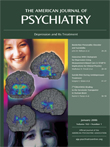Tourette’s Symptoms Provoked by Lamotrigine in a Bipolar Patient
To the Editor: Lamotrigine is a modern anticonvulsant with established antiepileptic and mood-stabilizing properties. We present the first case, to our knowledge, of an adult bipolar patient who developed multiple motor and vocal tics during treatment with lamotrigine.
Ms. A, a 55-year-old woman, was referred to our bipolar outpatient center by her general practitioner for frequent recurrent depressive episodes. Laboratory measures, including a CSF level, a magnetic resonance imaging scan, and an EEG, revealed no hint of an organic cause of her depressive symptoms. Because her history also revealed a manic episode, she was diagnosed as having bipolar I disorder with a rapid-cycling course. Lamotrigine monotherapy was initiated for mood stabilization and was titrated up to 200 mg/day (a blood level of 4.6 μg/ml).
For 3 months, Ms. A’s mood remained stable, but she began to develop tics of increasing extent and complexity. She started to produce motor tics, such as shrugging her right shoulder, wagging her hips, and pawing her feet on the ground. Moreover, she was picking at her clothes and blinking her eyes. In due course, she developed vocal tics for the first time in her life. Thus, she then had repetitive throat clearing, single expiratory grunts, and mental coprolalia.
At her follow-up visit, Ms. A reported a history of rare left shoulder shrugging and head nodding for 2 years before referral to our clinic. No previous vocal tics were reported. During childhood she suffered from mild orofacial motor tics that disappeared spontaneously after 6 months at the age of 7. At that time, no diagnosis was made. Thus, Ms. A had only two episodes of slight motor tics.
Suspecting an exacerbation of Tourette’s syndrome due to lamotrigine, we began to taper her lamotrigine dosage. With the reduction of lamotrigine to 100 mg/day, most of her symptoms faded and disappeared completely 2 weeks after total withdrawal.
Our literature search identified eight case reports describing the induction of tics in children with epilepsy treated with lamotrigine but none in adult nonepileptic patients (1, 2). In line with these case reports, most of Ms. A’s symptoms disappeared after dose reduction, indicating a dose-dependent side effect. An explanation for the exacerbation of Tourette’s syndrome during lamotrigine treatment remains speculative.
Inhibition of excitatory amino acid release can alter dopamine uptake in the striatum (3). In addition, the potent inhibitory effect of lamotrigine on the presynaptic release of excitatory amino acids might also modify striatal dopamine uptake (4) and lead to the occurrence of Tourette’s syndrome.
1. Sotero de Menezes MA, Rho JM, Murphy P, Cheyette S: Lamotrigine-induced tic disorder: report of five pediatric cases. Epilepsia 2000; 41:862–867Crossref, Medline, Google Scholar
2. Lombroso CT: Lamotrigine-induced tourettism. Neurology 1999; 52:1191–1194Crossref, Medline, Google Scholar
3. Cheung H, Kamp D, Harris E: An in vitro investigation of the action of lamotrigine on neuronal voltage-activated sodium channels. Epilepsy Res 1992; 13:107–112Crossref, Medline, Google Scholar
4. Singer HS, Hahn IH, Moran TH: Abnormal dopamine uptake sites in postmortem striatum from patients with Tourette’s syndrome. Ann Neurol 1991; 30:558–562Crossref, Medline, Google Scholar



